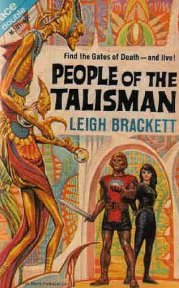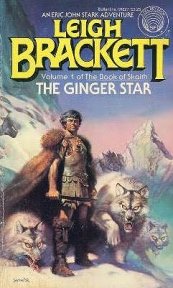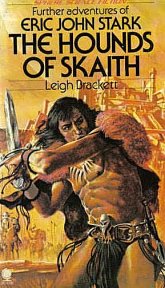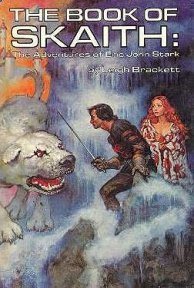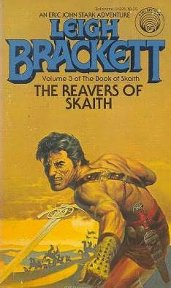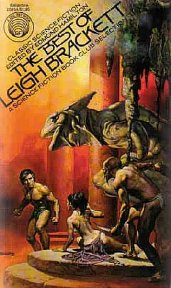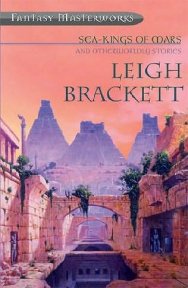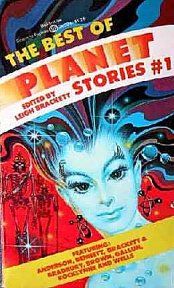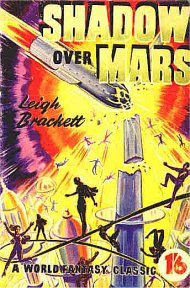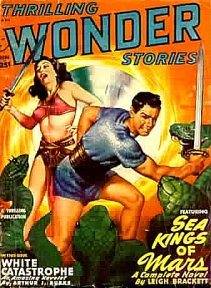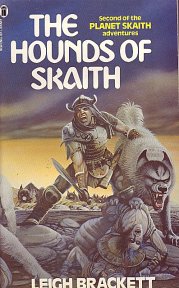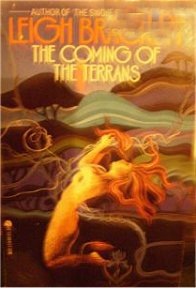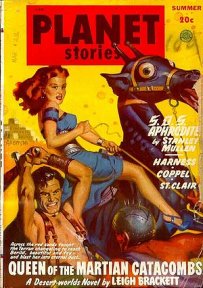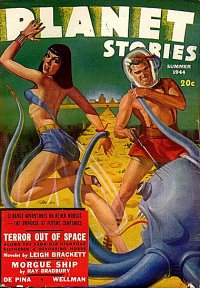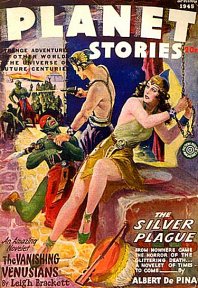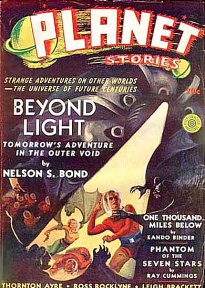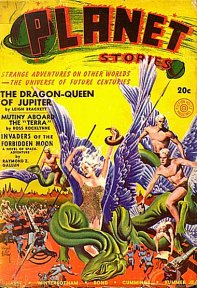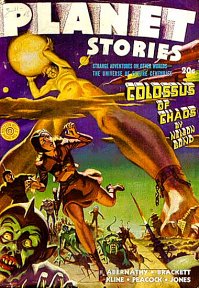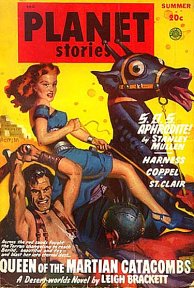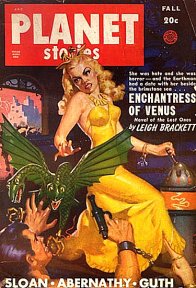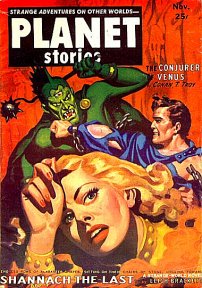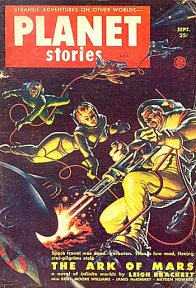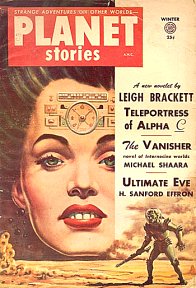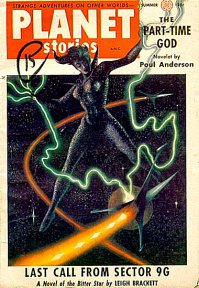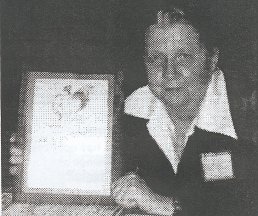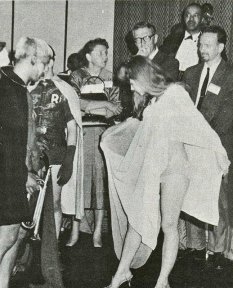APPENDICES
Appendix 1: Brackett's Mars Stories
For the record, I'll make no bones about the debt that
I owe to an unnamed author or authors who produced a remarkably comprehensive
overview of Brackett's Mars, and indeed, of her solar system on the Wikipedia.
I've given the URL's for the Wikipedia articles and highly recommend them.
But I can also claim to have read a fair proportion of her Mars stories.
Following is the complete list of Brackett's Mars or Mars-related tales,
taken from the Wikipedia article, with notations as to the ones I've read.
-
Martian Quest (Astounding Science Fiction February 1940)
(short story)
-
The Treasure of Ptakuth (Astounding April 1940) (short story)
-
Water Pirate (Super Science Stories January 1941) (short
story)
-
Interplanetary Reporter (Startling Stories May 1941) (short
story)
-
No Man's Land in Space (Amazing Stories July 1941) (novelette)
-
The Sorcerer of Rhiannon (Astounding February 1942) (novelette)
-
Outpost on Io (Planet Stories November/Winter 1942) (short
story)
-
The Halfling (Astonishing Stories February 1943) (novelette)
-
The Citadel of Lost Ships (Planet Stories March 1943) (short
story)
-
Shadow Over Mars (Startling Stories Fall 1944) published
in book form as
-
The Nemesis from Terra (novel)
-
The Veil of Astellar (Thrilling Wonder Stories Spring 1944)
(novelette)
-
The Beast Jewel of Mars (Planet Stories Winter 1948) (short
story)
-
Sea Kings of Mars (Thrilling Wonder Stories June 1949)
published in book form as
-
The Sword of Rhiannon (novelette)
-
Queen of the Martian Catacombs (Planet Stories Summer
1949) published in book form as
-
The Secret of Sinharat (novel or novelette)
-
Black Amazon of Mars (Planet Stories March 1951) published
in book form as
-
People of the Talisman (novel or novelette)
-
The Last Days of Shandakor (Startling Stories April 1952)
(novelette)
-
The Ark of Mars (Planet Stories September 1953) later published
as part of the book
-
Alpha Centauri or Die! (novelette)
-
Mars Minus Bisha (Planet Stories January 1954) (short
story)
-
The Road to Sinharat (Amazing Stories May 1963) (novelette)
-
Purple Priestess of the Mad Moon (The Magazine of Fantasy
and Science Fiction October 1964) (short story)
Of Brackett's core Martian stories, I can claim to have read
ten (set out in boldface), including seven novels or novelettes.
I've missed five core stories, and four peripheral Mars stories, most of
these are shorter works. Still, I think I've got enough of
a background to talk about it. I've missed many of the early
Mars stories, but these are short works, and in my view, these would have
been earlier in her career and probably even closer to Barsoom.
Some notes on the some of the Martian stories:
Queen of the Martian Catacombs and Black Amazon of Mars,
were revised and substantially expanded from stories to novel or novella
lengths and under the titles of People of the Talisman and
Secret of Sinharat, in an Ace Double paperback in 1964, and published
again under the book title Eric John Stark: Outlaw of Mars.
Eric John Stark also featured in a story called the Enchantress of Venus
in 1949, which clearly follows up from the Martian stories, and contains
a throwaway reference to Sinharat.
The Skaith trilogy (The Ginger Star, Hounds
of Skaith and Reavers of Skaith) published between 1974 and
1976, also featured Eric John Stark, but took place in universe in
which humans seem to have had interstellar travel for some time
which is not at all the case for the other Solar System stories, obviously
a parallel universe Stark (Or possibly, Stark is simply somehow heir to
Barsoomian level longevity, and he's simply lived long enough to see interstellar
travel). Stark and the Star Kings, published in 2005, takes
place in Edmond Hamilton's Star King universe (Brackett was married to
Hamilton, and he apparently also did substantial revisions on the two Outlaw
of Mars novels), obviously another parallel universe (or a very long life).
For my purposes, I'm only referring to the two novels or novellas published
in Eric John Stark: Outlaw of Mars.
Purple Priestess of the Mad Moon, The Road to
Sinharat,
Mars Minus Bisha and the Last Days of Shondakor
and the Beast Jewel of Mars is published collectively as The
Coming of the Terrans.
On the other hand, the Sword of Rhiannon and Nemesis
from Terra are full fledged stand alone novels, published singly.
The Halfling is published in a Brackett short story
collection of the same name, which also includes the Enchantress of
Venus. The three or four other stories in the collection
are not related to Mars, Venus or Brackett's solar system.
Brackett also edited an anthology,
Best of Planet Stories, which
contains her collaboration with Bradbury ‘Lorelei of the Red Mist’, set
in the same area of Venus as Enchantress of Venus.
The other stories: Interplanetary Reporter,
No Man's Land In Space, Outpost on Io, the Halfling are only tangentially
related to Brackett's Mars. The planet is featured mostly by passing
reference, rather than having its plot intrinsically set there.
The Ark of Mars begins on what is recognizably Brackett's Mars,
though apparently at a distant future time; however, it soon leaves it.
Citadel of Lost Ships is not set on and does not touch directly
on Mars at all, but although I haven't read it, I've included it here for
my own reasons.
Appendix 2: Brackett's Venus Stories
In addition to some fourteen Mars stories and novels,
Brackett published a series of Venus stories. The Venus stories
were less ambitious, perhaps seven short stories and novellas among them,
nothing approaching novel length.
-
The Dragon Queen of Jupiter (Planet Stories Summer 1941)
also published as
-
The Dragon Queen of Venus
-
The Halfling (novelette; Astonishing Stories February
1943)
-
The Citadel of Lost Ships (Planet Stories March 1943)
-
Terror Out of Space (Planet Stories Summer 1944)
-
The Vanishing Venusians (novelette; Planet Stories Spring
1945)
-
Lorelei of the Red Mist (novella; Planet Stories Summer
1946), with Ray Bradbury
-
The Moon That Vanished (novelette; Thrilling Wonder Stories
October 1948)
-
Enchantress of Venus (novella; Planet Stories Fall 1949)
also published as
-
City of the Lost Ones
Of the eight stories, I've read only three of them.
In addition, there were another five stories which touched on or dealt
with Venus but were not focused principally there.
-
The Stellar Legion (Planet Stories Winter 1940)
-
The Demons of Darkside (Startling Stories January 1941)
-
Interplanetary Reporter (Startling Stories May 1941)
-
No Man's Land in Space (novelette; Amazing Stories July 1941)
-
Outpost on Io (Planet Stories November/Winter 1942)
It's harder to reconcile Brackett's Venus with the Venus
of Kline, Farley and Burroughs. Barsoom was a towering landmark
work. Amtor was sort of always a weak sister in the Burroughs canon,
and hardly as defining or definitive of Venus as Barsoom was of Mars.
The depiction of Venus seems to have hewed closer to the general narrative
and did not hue nearly so specifically or closely to any one author's vision.
Indeed, there are aspects to Brackett's vision of Venus
that seem dramatically inconsistent with Burroughs or Kline's or Farley's
Venuses, and seem much harder to explain in terms of the political and
economic impacts of colonialism or foreign perspectives. However,
without a better look at more of the Venus stories, its difficult, if not
impossible to say anything with certainty.
The two principle stories or novellas of Venus I've read
have been Lorelei of the Red Mists and Enchantress of Venus.
The Halfling is set on Earth, but features Venusian animals and references,
among others. Both of the principal stories focus on a large
lake or inland sea in highlands sheltered by a mountain range which has
the unique character of being filled, not with water, but with a heavy
gas which is thick enough to swim in and to float boats, the gas is so
suffused with oxygen that it is breathable. In terms of the
real Venus, or the collective Burroughs/Kline/Farley map, this would probably
be located inland of the equatorial continent, along the central mountain
range. The people around this sea seem to be closest ethnically
to Kline's Zarovians. Brackett's Venus, and they seem to speak a
universal planetary language, consistent with the other writers.
Referred to from the Wikipedia article are forms of Plant
Men who seem roughly analogous to Burroughs Brokols, as well as Amphibian
Men who might be loosely related to the Lu of Caprona, to Burroughs Myposans
or Kline's Toad Men of Venus.
And that's all that I can really say. The
simple fact is that Brackett's Venus work is much smaller than her Mars,
and I've read comparatively less of it.
Appendix 3: The Moon Maid Conflict
Although Brackett works well in terms of giving us a picture
of Barsoom and its experience with western colonialism, we do have a problem
in that events seem to diverge from Burroughs Moon Man stories.
Its tricky. As I've noted, in Brackett, the dates
given for titles of her collection ‘The Coming of the Terrans’ suggest
that Earth may have been exploring space or establishing relations with
Mars as early as the 1980s or 1990s. Presumably communication might
have begun even before that, perhaps as early as the 1960s.
On the other hand, I've questioned this, putting a guess
for Mars colonial period as late as the 22nd to 23rd or 24th centuries.
If you look at the chronology of Burroughs Moon Maid series,
it seems pretty incompatible. Formal communication begins around
1967, which we can reconcile with Brackett.
But then, the efforts at space travel, by Barsoom is in
2015. In 2024 and 2026, Earth ships attempt to reach Barsoom,
but fail to make it. We have Julian and Orthis fighting it out in
The Moon Maid. This is obviously completely inconsistent
with the dates put forward in
Coming of the Terrans since in those
dates, Earth's influence is well established on Mars.
To make matters worse, in the Moon Man, Orthis
invades and conquers Earth (or at least North America) in 2050.
This domination extends up until the 25th century. This seems
completely incompatible with the events and references in Brackett's solar
system stories, which have Earth being active in dominating the rest of
the solar system, and in particular, North America being a key industrial
and political player in Earth. There are several references to New
York.
There are some possible resolutions. One is
to simply suggest that the Moon Maid series never happened.
It was related to us as prophecy, with people in a ‘real time’, relating
the prophetic flashbacks from their future descendants lives.
So, the obvious solution is that with forewarning, people changed their
actions and the events never came to pass. Indeed, that might
have been the whole point of the characters relating their stories to Burroughs
who is in these fictions, initially a successful and widely read writer,
and later in the beginning of the Moon Man, a high government official.
In either role, he might well have derailed this potential future.
Or we could argue that the Brackett Mars never happened,
obviously because its written by Burroughs. So only Burroughs fits
in the Burroughs Universe. Original author trumps.
Another approach is to simply say that the Moon Maid
series and the Colonial Barsoom stories are simply two different parallel
worlds, springing from John Carter's original timeline.
Or, perhaps the wildest theory is to accept the Moon
Maid sequence, and Brackett's Mars as both taking place in the same
Universe. On this line, what we'd argue is that although the
Kalkars conquered, their conquest was restricted to North America.
The rest of the world, particularly Europe, England and Australia, went
along on its merry way. Perhaps some enclaves of North America,
like New York, continued on in the modern fashion. Or perhaps
refugees from America founded a new New York or N'York in Australia or
Latin America. As Earth dominated the solar system, the Kalkars
in North America grew increasingly feudal and backwards? Ridiculous?
Perhaps. But we do have the example of Eastern Europe and Ceaucescu's
Romania, which grew increasingly feudal and backwards while other parts
of the world moved forward.
In any event, I'm just tossing it out there.
The reader who cares can make their own judgments and draw their own conclusions.



